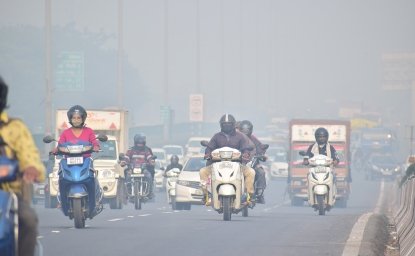290. Ethnic Cleansing, Communism and Environmental Devastation in Post-War Czechoslovakia

Eagle Glassheim is Assistant Professor of History at Princeton University. He spoke at an EES noon discussion on January 7, 2004. The following is a summary of his presentation. Meeting Report 290.
In the aftermath of World War II, Czechoslovakia expelled close to three million ethnic Germans into occupied Austria and Germany. These so-called Sudeten Germans had long lived in borderland regions ringing the provinces of Bohemia and Moravia, with the heaviest concentration inhabiting the industrially advanced north and west of Bohemia. During and after the expulsions, over two million Czechs settled in the formerly German areas, taking over houses, businesses and factories. The popular Communist Party controlled the resettlement process from the beginning in 1945, using its influence to create a web of patronage in the borderlands. This helped the Party win over 50 percent of the vote in north Bohemia in free elections in May of 1946. Even before Stalinism took hold in Czechoslovakia in 1948, north Bohemia's coal mining, power production and chemical industry were renowned. With the onset of a Communist policy of heavy industrialization, north Bohemia's industry became a model for the entire country. By the 1960s, north Bohemia also became known for its almost unrivaled pollution, with air and water so foul that trees died in waves and children decamped to the mountains for doses of clean air.
Some observers have suggested a link between the expulsion of the Sudeten Germans and the subsequent environmental devastation of the region. Writing under a pseudonym in the 1980s, the dissident Petr Príhoda argued that new settlers lacked a sense of place. In contrast, the long-established Sudeten Germans had held strong regional identifications, tied closely to the built and natural landscape (their "Heimat" or homeland). According to Príhoda, Czech newcomers were alienated from the land and each other, allowing easy control by a Communist Party intent on exploiting the region's natural resources and industry, regardless of the human and environmental costs. This Heimat-deficit theory, as I call it, has a certain elegance, but it also raises a lot of questions. How exactly does one determine the existence or the intensity of Heimat? Inherently subjective, Heimat can be as slippery to analyze as other forms of identity. Beyond the difficulties surrounding Heimat, is it possible to separate the legacy of the expulsion from that of Stalinist industrial policy in the 1950s? And if we are looking for easy explanations, why not blame north Bohemia's problems on coal, which exists there in abundant and impure form, lying tantalizingly close to the surface of the earth? Indeed, are not alienation and anomie widespread manifestations of industrial modernity more widely?
In exploring the connection between the expulsions and environmental decline, I have sought grounds on which to test the Heimat-deficit theory—above all, I have been looking at conceptions of landscape and regional identity. Contrary to Príhoda, I have found that a strong regional identity did develop in north Bohemia during and after resettlement in the latter half of the 1940s. In contrast to Sudeten German romantic, pastoral and historical visions of homeland, however, Czech settlers and settlement officials stressed a modern, production-oriented, materialist identity. Rather than a lack of solidarity and identification, then, it was these new visions of an industrial landscape that contributed to the region's infamous environmental mess in the 1960s and beyond.
Building a new identity in the borderlands
Expulsion and resettlement occurred simultaneously from mid-1945 through the end of 1946. As Germans left their homes and businesses, Czechs poured into the borderlands in search of property and a new life. At first unregulated and often lawless, both processes came under the control of the Communist-dominated Settlement Office in late 1945. Both in the "wild" phases of 1945 and in the organized period of 1946, settlers and officials aimed to transfer German property to Czechs and restore or maintain the Sudetenland's economic productivity. At the same time, Czechs sought to stake a moral and historical claim to the region. The Settlement Office highlighted Czech historical connections to the borderlands, while settlers and local officials removed German signs and cultural markers.
But neither the removal of German signs nor the promotion of a Czech historical narrative seemed to consolidate conditions in the somewhat chaotic borderlands. Settlers moved from house to house, job to job, but the problems of theft and low labor morale remained well into 1946. Coming from a range of regions and backgrounds, settlers seemed to lack solidarity and a strong sense of purpose (beyond looters, who knew their role quite clearly). By 1946, the Settlement Office had resolved to foster a new sense of regional identity and solidarity in the borderlands. Rather than pre-war German romantic identifications with the natural landscape and historical monuments, new identities—at least for northern Bohemia—were to be modern and materialist, highlighting industry and production. North Bohemia would be a model and a laboratory of socialist modernity.
Coal mining and miners in the north Bohemian brown-coal basin became emblematic of this new identity. Coal was "the blood pouring into the arteries" of the country's industry, according to the Communist daily Rudé Právo in September 1945. The Settlement Office made coal its number one priority, as labor shortages threatened to slow output during Czechoslovakia's post-war reconstruction. The status of miners rose accordingly, illustrated by this rhyming slogan on the banners of miners visiting the capital city: "Prague, don't forget when you fire up the heat, from the sweat of our miners, we're building a new state."
When the Communists took total control of the Czechoslovak state in 1948, the Stalinist regime began a policy of heavy industrialization and collectivization of agriculture. Already a showpiece of industrial planning and socialist modernity, north Bohemia made this transition smoothly and proved a consistent bastion of Communist support.
The environment and materialist identities
Though regional Communist officials noted serious environmental problems as early as 1960 in north Bohemia, the crisis reached its height in the early 1980s. During a notorious inversion in 1982, a blinding smog stopped traffic, sent pensioners to the hospital, and further exacerbated respiratory problems among children. It was one of many such episodes in the region, where smoke and toxic chemicals weakened and killed trees, rivers, and people. Indeed, life expectancy for the north Bohemian brown coal region averaged three to five years lower than in non-polluted areas of Czechoslovakia in the 1980s.
Coal was both the economic wellspring of the region and its biggest polluter. As Czechoslovakia's industrial output increased from the 1950s to the 1980s, the Communist regime steadily raised coal production and built new power plants in the north Bohemian basin. The region's sprawling surface mines expanded voraciously, swallowing 116 villages and parts of several larger cities by 1980. Notoriously, the historic center of the city of Most was destroyed in the late 1960s and early 1970s in order to mine a rich vein of coal. "New Most" squeezed tens of thousands of people into cheaply built panel housing, offering little by way of culture, greenery or services. Most became emblematic of the regime's obsession with output and production, regardless of the human cost. Visitors to Most and north Bohemia after the mid-1960s described the region as a moonscape, a battlefield and a wasteland.
While there were some signs of disaffection among north Bohemians—most notably a small but steady stream of out-migrants—there is also evidence that many, and perhaps most, residents came to feel at home there. In a 1971 sociological study of the town of NeŠtemice (an industrial suburb of 3,200 people near Ústí nad Labem), residents expressed a sense of belonging and general satisfaction with life, in spite of high levels of pollution. Though 77.5 percent were newcomers to the town after 1945, the overwhelming majority (72 percent) said they felt at home there in 1971, and only 10.5 percent expressed a desire to leave. Poll respondents viewed the local factory (and significant polluter) positively, primarily for its contribution to the town's economic well-being. The study concluded that a certain "lack of a critical view" towards environmental problems stemmed from a close identification with the town and its factory. In fact, even in the relatively liberal 1960s, most complaints about the environment in north Bohemia came from local and regional Communist officials, not from ordinary citizens.
What accounts for this quiescence, and why did the central government continue with an industrial policy that had such dire environmental and human consequences? Indeed, north Bohemian officials calculated damages from coal mining and power production of eight billion crowns per year in the 1970s, casting doubt on economic rationales for such a policy. I would suggest that north Bohemia's fate stemmed from the materialist/productivist identities fostered by settlers and Communist officials after 1945. In both the popular and official mind, north Bohemia was a model of socialist modernity. Its residents took pride in its iconic factories and mines, and the region's success was measured by its output. At least until the 1980s, most residents appear to have agreed with the regime about the region's identity.
Conclusions
There are several contexts in which one might embed the north Bohemian disaster. On the one hand, it is a familiar story of communist indifference to both environmental and human health. The Soviet Union and other countries of the former Eastern Bloc all had their own stories of blight, indifference, and asphyxiation. At the same time, north Bohemia was a particularly hard hit area, one of the most environmentally devastated in Europe by several accounts. It was by far the most polluted area in Czechoslovakia, and explanations of its fate must account for this unique achievement. Furthermore, communist regimes did not have a monopoly on environmental destruction. Air pollution, toxic waste, urban blight, strip mining—all have been staples of development in capitalist democracies as well. They are more a function of modern industrial economies than of any particular regime. As I have argued here, the expulsion of the Sudeten Germans and subsequent resettlement process also had a role in the long-term decline of the region. Even so, other resettled borderland regions—in Czechoslovakia and Poland—did not suffer nearly as much as north Bohemia.
Northern Bohemia became a worst-case scenario—short of genocide or nuclear annihilation—of what communism, indeed modernity itself, could produce. Several factors came together to make this so. First, the region's geography (most notably its coal basin) made it attractive for industry, as well as particularly vulnerable to air pollution. Second, the expulsion of the Sudeten Germans called forth hundreds of thousands of acquisitive settlers, but also new understandings of regional identity. Third, this opening for new identities coincided with a leftward and materialist turn in post-war Europe, as production, the welfare state, and economic growth replaced nationalism as the foundation of political legitimacy. Fourth, Stalinist planners found northern Bohemia particularly well suited to their policy of heavy industrialization. Not only did the region offer abundant coal and an advanced industrial infrastructure, but it had also embraced a materialist identity that made it fertile ground for a productionist ideology.
Other than geography, all of these factors can be grouped under a rubric that David Harvey has called "universal or high modernism," an economic, social, and cultural order that flourished in the mid-twentieth century. With roots in the Enlightenment and more proximately in the 1920s and 30s, high modernism "has been identified with the belief in linear progress, absolute truths, the rational planning of ideal social orders, and the standardization of knowledge and production." The common denominator of Czechoslovakia's modernist triad of destructive forces was an inclination to re-engineer identities—of both people and spaces—to reflect a materialist philosophy. Expulsion, resettlement, Stalinist industrial policy, social engineering, and environmental exploitation—all show signs of a dystopian late modernity. Contextualizing the north Bohemian disaster most broadly, we should see it as a product not just of communism or resettlement alone, but also of a wider late modern drive for national purity and economic growth, regardless of the human and environmental cost. As Václav Havel has written, the "automatism" and materialism rampant under communism, the sacrifice of "spiritual and moral integrity" for material security, was not just an indictment of communism, but also a "warning to the West…[of] its own latent tendencies."
Author

Assistant Professor of History, Princeton University, NJ

Global Europe Program
The Global Europe Program is focused on Europe’s capabilities, and how it engages on critical global issues. We investigate European approaches to critical global issues. We examine Europe’s relations with Russia and Eurasia, China and the Indo-Pacific, the Middle East and Africa. Our initiatives include “Ukraine in Europe”—an examination of what it will take to make Ukraine’s European future a reality. But we also examine the role of NATO, the European Union and the OSCE, Europe’s energy security, transatlantic trade disputes, and challenges to democracy. The Global Europe Program’s staff, scholars-in-residence, and Global Fellows participate in seminars, policy study groups, and international conferences to provide analytical recommendations to policy makers and the media. Read more




